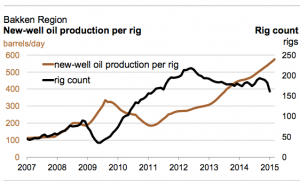EOG announced a strong fourth quarter for 2014 and revealed a disciplined 2015 spending plan that leverages their position to get them through the current difficult market. The company gives much of the credit for its success to the outstanding performance from its interests in the Bakken formation in North Dakota.
EOG reported its Q4 net income at $445 million, which stands in sharp contrast to many companies who saw losses as crude prices plummeted through the fall. Overall, 2014 brought a net income of $2,915 million for the company, compared to $2,197 million for 2013.
Related: Energy Giants Announce Layoffs
2015 Capital Plan
As EOG looks to the new year, they expect their capital expenditures to range from $4.9 to $5.1 billion. This number includes projects for production facilities and midstream expenditures and will primarily be directed to EOG's highest rate-of-return oil assets including the Bakken play. This is a 40 percent reduction compared to 2014 spending and Capital will be allocated
“Chairman and CEO, William R. “Bill” Thomas, commented that “EOG delivered both high returns and strong growth in 2014, a unique accomplishment in the energy sector. Our returns-focused capital discipline has been at the core of EOG’s culture since the very beginning. We are confident we will continue to earn healthy returns on our capital program during this commodity down cycle and, more importantly, emerge stronger and poised for significant long-term growth.”
The biggest news for 2015 is that additional development in the Bakken will be put on hold. The company's plans to utilize existing rigs and complete approximately 45 percent fewer wells in 2015 (25) versus 2014 (59). This tactic will prepares the company to resume strong growth when prices recover.





